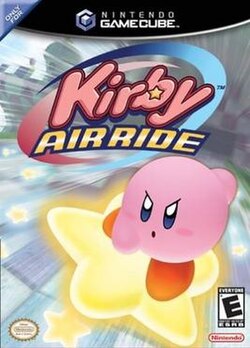Kirby Air Ride
| Kirby Air Ride | |
|---|---|

North American cover art
|
|
| Developer(s) | HAL Laboratory |
| Publisher(s) | Nintendo |
| Director(s) | Masahiro Sakurai |
| Producer(s) | Hiroaki Suga Masayoshi Tanimura Shigeru Miyamoto |
| Artist(s) | Kazuya Konishi |
| Composer(s) | Shogo Sakai Jun Ishikawa Hirokazu Ando Tadashi Ikegami |
| Series | Kirby |
| Platform(s) | GameCube |
| Release date(s) | |
| Genre(s) | Racing |
| Mode(s) | Single-player, multiplayer |
| Aggregate score | |
|---|---|
| Aggregator | Score |
| Metacritic | 61 out of 100 |
| Review scores | |
| Publication | Score |
| Edge | 3 out of 10 |
| EGM | 7 out of 10 |
| Famitsu | 34 out of 40 |
| Game Informer | 7 out of 10 |
| GamePro | |
| Game Revolution | C− |
| GameSpot | 5.1 out of 10 |
| GameSpy | |
| IGN | 5.2 out of 10 |
| Nintendo Power | 4.2 out of 5 |
Kirby Air Ride, known in Japan as Kirby's Airride (カービィのエアライド Kābī no Earaido?), is a 2003 racing game video game developed by HAL Laboratory and published by Nintendo for the GameCube video game console starring Kirby, one of HAL's characters.
Kirby Air Ride has the players and computer-controlled racers ride on Air Ride Machines. The game supports up to four players, and was the first GameCube title to support LAN play using broadband adapters and up to four GameCube systems.
Air Ride received a mixed reception from critics, who criticized the game's simplicity. However, the game was a commercial success, selling over 1.2 million copies worldwide.
Kirby Air Ride is played primarily through use of a vehicle, many of which are taken from previous Kirby games, such as the Warpstar. Players take control of Kirby or any of his multicolored counterparts to compete in races or other minigames.
The simple controls are a defining feature of Kirby Air Ride. Unlike most racers, no input is necessary for the craft to move forward. Other than the use of the Control Stick to steer, the A button performs all other actions in the game, including braking, charging up for a boost, sucking in nearby enemies and thereafter using the powers absorbed from them. Gliding is also a definitive feature of the game, as the player can control the crafts' altitude when they go airborne.
Each of the three modes of the game has a "checklist" associated with it. These are 12x10 grids which contain 120 squares, all of which are initially blank. Each square has a hidden goal contained inside it, and certain goals also have unlockable content attached to them, such as alternate machines, new items and courses, new characters, and music tracks for the sound test. When a goal is completed, the squares fill to reveal completed goals. In practice, this system of discovering unknown goals is balanced out by several goals which are relatively easy to obtain, such as "finish a race three times" or "race on every course," and various other goals which only require the accrual of play time; these, in turn, make it easier to find out what other, more specific goals are, since each goal unlocked will open up the objective of the goals touching the goal completed.
...
Wikipedia
